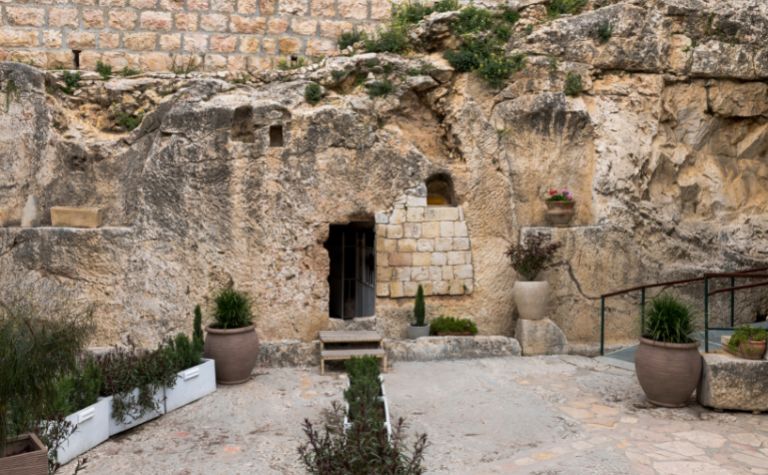The New Testament teaches that before Jesus rose from the dead, some of his followers placed his body in a tomb, where it lay for three days. The tomb, which had been cut out of a rock, belonged to Joseph of Arimathea. Even though Jesus’ body was in the tomb for a short time, many people today wonder where it’s located.
The traditional site of the tomb that contained Jesus’ body for three days is at The Church of the Holy Sepulchre. It’s located in the Christian quarter of the Old City of Jerusalem. The tomb itself consists of a rock cave. The location has had a violent history and has undergone several reconstructions.
What does the New Testament reveal about Jesus’ tomb and its location? What else does the Bible say about rock-cut tombs? How is Jesus’ burial place associated with Joseph of Arimathea? Why is the Roman Emperor Constantine important to the tombs’ location? Keep reading to learn the answers to these questions and others.
Also, see Who Was Crucified Next to Jesus? to learn more.

Joseph of Arimathea Laid Jesus’s Body in a Tomb of Rock
According to the Gospel of Mark, after the crucifixion of Jesus, Joseph of Arimathea asked the Roman governor Pontius Pilate for his body. When Pilate consented, Joseph took Jesus’ body down from the cross, wrapped it in cloths, and laid it in a tomb carved out of rock instead of a grave in the ground.
Mark 15:46 reads, “And Joseph bought a linen shroud, and taking him down, wrapped him in the linen shroud and laid him in a tomb that had been cut out of the rock. And he rolled a stone against the entrance of the tomb” (ESV). Three days later, Jesus’ disciples found the tomb empty (Matt. 28:1-10).
In the first century, wealthy people tended to own rock-cut tombs, not people in the lower classes. While Jesus and his family weren’t wealthy, Joseph of Arimathea was.
There is precedent for rock-cut tombs in the Old Testament. For example, Abraham bought one for his wife, Sarah (Gen. 23:20). Also see Judges 8:32; 2 Samuel 2:32; 2 Kings 9:28, 21:26, 23:16, 23:30; and Acts 7:16 for more biblical references to such burial places.
Also, see Why Did Jesus Curse the Fig Tree? to learn more.

The Turbulent History of Jesus’ Burial Place
Jesus’ tomb has a long and violent history, partly because the city of Jerusalem does. The area has experienced numerous wars, occupations, and sieges. Natural disasters have also impacted the area multiple times, including collapsing rocks from earthquakes and fires from arson.
Jesus’ tomb during the first and second century
Jerusalem experienced widespread destruction a few decades after Jesus’ death and resurrection when the Roman General, Titus, conquered the area. At that time, the holy city crumbled, leaving only stone rubble. Jesus’ tomb and the surrounding area weren’t spared from the wrath of Rome’s soldiers.
A few decades later, under the rule of Emperor Hadrian, the Romans filled in a sacred rock-cut tomb with cement. Some historians believe this may have been Jesus’ tomb, but no one knows for sure.
The tomb during the time of Constantine
In the fourth century, after Emperor Constantine publicly converted to Christianity, he sent his mother, Helena, and some companions, to Jerusalem to locate Jesus’ tomb.
A temple to Jupiter and Venus had existed on the spot of the tomb since the second century, so they destroyed it. In the process, they believed they unearthed Jesus’ tomb.
Quoting the church historian Eusebius (260-339 A.D.), one historian writes, “The temple was torn down, the ruins were removed to a distance, the earth beneath, as having been contaminated, was dug up and borne far away. Then, ‘beyond the hopes of all, the most holy monument of Our Lord’s Resurrection shone forth’ (Eusebius, Life of Constantine, III, xxviii).” [1]
Ever since Constantine and Helena allegedly found the tomb, most Christians, including Roman Catholic, Greek Orthodox, and Armenian Apostolic branches of the faith, have believed that is its correct location.
Since then, the site has experienced much destruction and restoration. The Oxford Dictionary of Christianity states, “The present church largely dates from 1810, though some of the earlier bell tower (1160-80) remains, in a poor state of repair.” [2]
Also, see Who Did Jesus Raise from the Dead? to learn more.

Jesus was buried outside Jerusalem
Hebrews 13:12 reveals that Jesus was buried outside the city of Jerusalem: “So Jesus also suffered outside the gate in order to sanctify the people through his own blood.” (ESV). Another translation clarifies that the tomb was outside the “city gates” (NLT). (Also see John 19:17, “he went out,” ESV).
The writer of Hebrews is referring to Leviticus 16:27, “And the bull for the sin offering and the goat for the sin offering, whose blood was brought in to make atonement in the Holy Place, shall be carried outside the camp. Their skin and their flesh and their dung shall be burned up with fire” (ESV, emphasis added).
New Testament scholar Thomas Schreiner explains: “A parallel and contrast are drawn between Jesus’ suffering and the fate of animals. Just as sacrificial animals were burned outside the camp, so Jesus suffered outside the gate. The gate here refers to the walls of Jerusalem, indicating that Jesus died outside the city limits of Jerusalem (John 19:17-20).” [3]
Today Jesus’ tomb lies inside the city limits of Jerusalem
Today, the tomb lies inside the city of Jerusalem. Historians believe that Herod Agrippa expanded the city’s boundaries about a decade after Jesus’ crucifixion. The new boundaries located the cave inside the city limits.
The Dictionary of the Christian Church summarizes: “The site has been inside the city walls since A.D. 41-44, when Herod Agrippa had a third wall built; recent archaeological evidence investigation has at last clarified the fact that the site lay outside the city wall before then (cf. Heb. 13:12).” [4]
Also, see Why Was Jesus Crucified? to learn more.
References:
[1] Source
[2] The Oxford Dictionary of Christianity. p. 659.
[3] Hebrews by Thomas Schreiner. p. 421.
[4] The Dictionary of the Christian Church. p. 476-477.
Related Questions
A lot of people know that Jesus of Nazareth lived a long time ago. They may even know that he was a Jewish man born at the time of the Roman Empire. Yet, they are unclear about exactly when he was on...
There are 66 individual books in the Bible. There are 39 in the Old Testament and 27 in the New Testament. Many readers can read the shortest books in the Bible in 5 to 10 minutes. The longest book...
